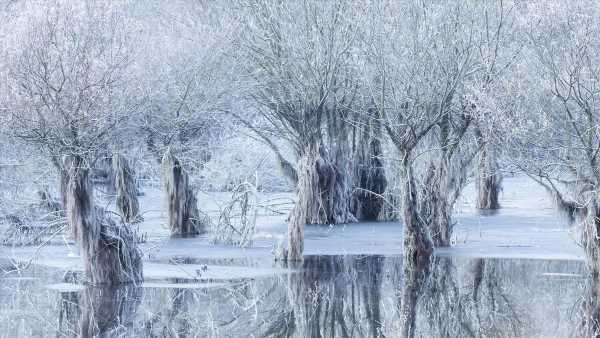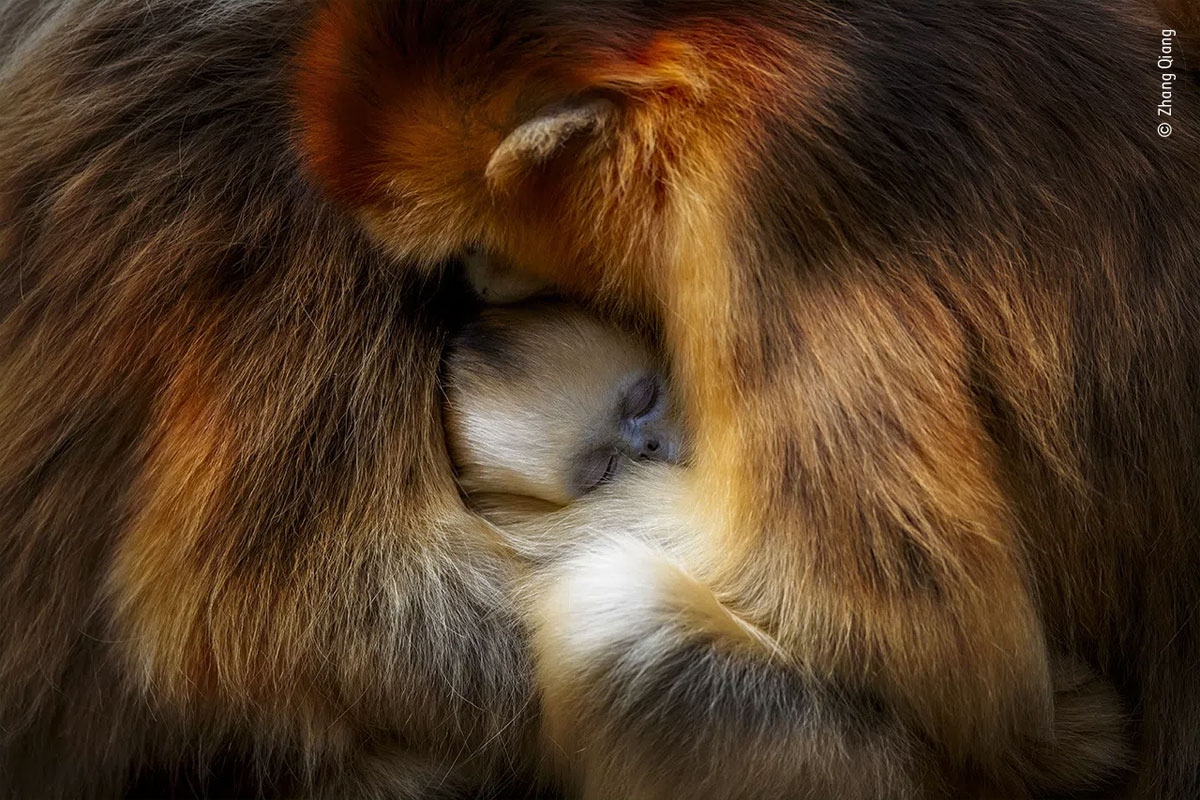The results for the People’s Choice Award for the Wildlife Photographer Of The Year are in.
Out of the more than 50,000 images that were entered for the Wildlife Photographer of the Year competition, the judges could only award 100 winners.
So now, each year the Natural History Museum chooses an additional 25 photographs, of which it asks the public to select the recipient of the People’s Choice Award.
Here are the top images voted for by the public in this year’s People’s Choice Award.
Please click on the images for a look at the winners.
Photograph: Cristiano Vendramin/Wildlife Photographer of the Year
Santa Croce Lake is a natural lake located in Belluno, Italy.
In winter 2019, Cristiano noticed the water was unusually high and the willow plants were partially submerged, creating a play of light and reflections.
Waiting for colder conditions, he captured the scene in icy stillness.
After taking the image, he was reminded of a dear friend, who had loved this place and is now no longer here, “I want to think he made me feel this feeling that I’ll never forget. For this reason, this photograph is dedicated to him”.
Equipmemt used: Canon EOS 6D + 100-400mm f4.5-5.6 IS USM II lens; 1/8 sec at f8; ISO 200; Lee polariser; remote control; Feisol tripod.
Photograph: Ashleigh McCord/Wildlife Photographer of the Year
During a visit to the Maasai Mara in Kenya, Ashleigh captured this tender moment between a pair of male lions.
At first, she had been taking pictures of only one of the lions, and the rain was just a light sprinkle, although the second had briefly approached and greeted his companion before choosing to walk away.
But as the rain turned into a heavy downpour, the second male returned and sat, positioning his body as if to shelter the other.
Shortly after they rubbed faces and continued to sit nuzzling for some time.
Ashleigh stayed watching them until the rain was falling so hard that they were barely visible.
Equipment used: Nikon D500 + 300mm f2.8 lens; 1/200 sec at f2.8; ISO 720.
Photograph: Jo-Anne McArthur/Wildlife Photographer of the Year
Jo-Anne flew to Australia in early 2020 to document the stories of animals affected by the devastating bushfires that were sweeping through the states of New South Wales and Victoria.
Working exhaustively alongside Animals Australia (an animal protection organisation) she was given access to burn sites, rescues and veterinary missions.
This eastern grey kangaroo and her joey pictured near Mallacoota, Victoria, were among the lucky ones.
The kangaroo barely took her eyes off Jo-Anne as she walked calmly to the spot where she could get a great photo.
She had just enough time to crouch down and press the shutter release before the kangaroo hopped away into the burned eucalyptus plantation.
Equipment used: Nikon D4S + Sigma 120–400mm f4.5–5.6 lens; 1/500 sec at f5.6; ISO 2500.
Photograph: Jeroen Hoekendijk/Wildlife Photographer of the Year
Black bear cubs will often climb trees, where they wait safely for their mother to return with food.
Here, in the depths of the temperate rainforest of Anan in Alaska, this little cub decided to take an afternoon nap on a moss-covered branch under the watchful eye of a juvenile bald eagle.
The eagle had been sitting in this pine tree for hours and Jeroen found the situation extraordinary.
He quickly set out to capture the scene from eye-level and, with some difficulty and a lot of luck, was able to position himself a bit higher on the hill and take this image as the bear slept on, unaware.
Equipment used: Canon EOS 5D Mark III + Sigma 150–600mm f5.0–6.3 lens; 1/320 sec at f6.3; ISO 640.
Photograph: Qiang Guo/Wildlife Photographer of the Year
In the Lishan Nature Reserve in Shanxi Province, China, Qiang watched as two male golden pheasants continuously swapped places on this trunk – their movements akin to a silent dance in the snow.
The birds are native to China, where they inhabit dense forests in mountainous regions.
Although brightly coloured, they are shy and difficult to spot, spending most of their time foraging for food on the dark forest floor, only flying to evade predators or to roost in very high trees during the night.
Equipment used: Nikon D5 + 400mm f2.8 lens; 1/2500 sec at f/2.8; ISO 320.
Seeing the top 5 images voted by the public, We can’t but not show you some of the rest of the 25 images that mesmerise!
Photograph: Zhang Qiang/Wildlife Photographer of the Year
Zhang was visiting China’s Qinling Mountains to observe the behaviour of the Sichuan snub-nosed monkey.
The mountains’ temperate forests are the endangered monkeys’ only habitat, which in itself is under threat from forest disturbance.
Zhang loves to watch the dynamics of the family group — how close and friendly they are to each other. And when it is time to rest, the females and young huddle together for warmth and protection.
This image perfectly captures that moment of intimacy.
The young monkey’s unmistakable blue face nestled in between two females, their striking golden-orange fur dappled in light.
Equipment used: Canon EOS 1D X Mark II + EF 800mm f5.6L IS USM lens; 1/400 sec at f6.3; ISO 800; AV model.
Photograph: Yung Sen Wu/Wildlife Photographer of the Year
It was the schooling barracudas at Blue Corner, Palau, in the western Pacific, that grabbed Yung’s attention while diving in the turquoise seascape.
He had been swimming with them for four days, but their formation constantly changed shape and he could not find the perfect angle.
On the fifth day his luck changed when the fish seemed to accept him into the group.
Surrounded by the barracudas, he started to imagine how one fish sees another while swimming, and this was the picture he wanted.
The fish were fast, and he had to swim hard to keep his place in the school.
At the end of an exhausting 50 minutes, he got his perfect ‘fish eye’ view.
Equipment used: Canon EOS-1D X Mark II + EF 11–24mm f4L USM lens; 1/250 sec at f14; ISO 400; Seacam housing; Seacam Seaflash 150D.
Photograph: Thomas Peschak/Wildlife Photographer of the Year
This group of meerkats in the Tswalu Kalahari Reserve in South Africa has been habituated to humans for over a decade, and is very relaxed around people.
In fact, they mostly completely ignored Thomas’s presence, being way too preoccupied with lounging, hunting, grooming and fighting.
He was therefore able to get in close and use a wide angle lens to include the arid savannah and mountains they call home.
To capture the meercats features, he applied techniques used for people in a portrait session, and used studio lights to photograph them.
Equipmemt used: Nikon D5 + 16–35mm f4 lens; 1/250 sec at f16; ISO 200, 2x Profoto B1 flash.
Photograph: Peter Delaney/Wildlife Photographer of the Year
Peter looked on as a herd of elephants closed ranks, pushing their young into the middle of the group for protection.
A bull elephant had been trying to separate a newborn calf from its mother.
Peter was photographing the herd in Addo Elephant Reserve, South Africa, when the newborn let out a shriek.
The herd reacted instantly — blowing loud calls, flapping ears and then surrounding the young and reaching out their trunks for reassurance.
Elephants create bonds that last a lifetime, and they can show emotions from love to anger.
Peter feels ‘There is something magical and beautiful when you observe elephants — it touches your soul and pulls at your heartstrings.’
Equipment used: Fujifilm X-H1 + XF 200mm lens; 1/5000 sec at f2; ISO 200; handheld.
Photograph: Minghui Yuan/Wildlife Photographer of the Year
There were several big trees near Minghui’s hotel in the Xishuangbanna Tropical Botanical Garden in Yunnan Province, China, and he’d noticed green tree ants on the trunks and was fascinated by their behaviour.
This species of ant builds its nest in the tree crown, are ferocious by nature and good at catching all kinds of insects.
One morning Minghui noticed a group of ants working together in perfect unity to restrain a green katydid.
These remarkable ants don’t always kill, they have been observed ‘farming’ certain types of insects, including leafhoppers.
The ants offer leaf hoppers protection from predators and parasites so that they can feed on the sweet sap the leafhoppers excrete.
Equipmemt used: Nikon D500 + 85mm f3.5 macro lens; 1/400 sec at f14; ISO 400.
Photograph: Michiel Van Noppen/Wildlife Photographer of the Year
Michiel took this photo of Dantita, as she is fondly known, at the foothills of Braulio Carrillo National Park, close to San José in central Costa Rica.
The Baird’s tapir or ‘gardeners of the forest’ are extremely important to their natural habitat, with some seeds only germinating after passing through the tapir.
But due to threats from deforestation and hunting, there are estimated to be only 6,000 individuals left in the wild.
Conservation groups such as Proyecto Tapir Nicaragua and Nai Conservation have been set up to work closely with local communities to promote the importance of preserving the land and protecting an endangered species.
Equipment used: Canon EOS 1D X + 16–35mm f2.8 lens; 1/40 sec at f7.1; ISO 5000; 2x Yongnuo speedlite yn600ex-rt; Pixel Pawn remote control.
Photograph: Maxime Aliaga/Wildlife Photographer of the Year
Taking care of a young orangutan requires a lot of energy.
Maxime spent more than one hour observing this mother in the Pinus Jantho Nature Reserve of Sumatra, Indonesia, trying to keep her excitable baby with her in the nest.
Since 2011 the Sumatran Orangutan Conservation Program has released more than 120 confiscated apes into the reserve.
Their goal is to establish new wild populations as a safety net against decline.
This mother, Marconi, was once held captive as an illegal pet but was nursed back to health and released in 2011.
In 2017 she was spotted with a wild-born baby, Masen, a symbol of hope for the future population.
Equipment used: Canon EOS 7D Mark II + 100–400mm f4–5.6 IS USM II lens at 400mm; 1/320 sec at f5.6; ISO 1600.
Photograph: Marco Gaiotti/Wildlife Photographer of the Year
Marco was watching this little Arctic fox as it incessantly called another nearby.
Gradually he noticed the fox’s wet breath was quickly freezing in the air after each call.
It was late winter in Spitsbergen, Svalbard, and the cold arctic air was -35°C (-31°F).
Photographing arctic foxes is often frustrating, as they are normally running around fast in search of food, but this one was very relaxed and let Marco get close enough to focus on it, with the light glowing perfectly in the background.
Equipmemt used: Canon EOS 5D Mark IV + 70–200mm f2.8 II lens; 1/1600 sec at f5; ISO 400.
Photograph: Karl Samitsch/Wildlife Photographer of the Year
Karl was in the Cairngorms, Scotland, with a friend who took him to a forest where red squirrels were used to being fed.
They placed hazelnuts on opposite branches of two trees and Karl then positioned his camera on a tripod between the branches facing the direction a squirrel might jump.
Setting his camera to automatic focus, he waited in camouflage gear behind a tree, holding a remote control.
After less than an hour, two squirrels appeared. As they leapt between the branches, he used the high-speed burst mode on his camera, and of the 150 frames, four were sharp, and this one perfectly captured the moment.
Equipmemt used: Canon EOS-1D X Mark II + 200–400mm f4 lens + 1.4–560mm converter; 1/1600 sec at f5.6 (-0.3); ISO 3200; remote control cable; Gitzo tripod.
Photograph: Dhritiman Mukherjee/Wildlife Photographer of the Year
For Dhritiman, Bhutan is an amazing place. He loves how most of the people try to live together with nature.
Satyr tragopans, a rare species of Asian pheasant, are widely hunted for food and plumage and are normally skittish and very shy.
But in this village near Punakha, the birds appear at ease and perfectly relaxed in the presence of the people who live there.
Before he captured this image, Dhritiman had been trying to photograph the satyr tragopan in India since 2008, but the birds would always run away the minute they spotted him.
Upon hearing of communities in Bhutan coexisting harmoniously with the species he knew he had to witness it for himself.
Equipmemt used: Nikon D610 + 14-24mm f2.8 lens; -80 sec at f14; ISO 4000.
Photograph: Antonio Liebana Navarro/Wildlife Photographer of the Year
Iberian lynx are one of the world’s most endangered cats due to habitat loss, decreasing food sources, car hits and illegal hunting.
But thanks to conservation efforts the species is recovering and can be found in small areas of Portugal and Spain.
Antonio captured this image while leading a conservation project based around photography in Peñalajo, Castilla La Mancha, Spain.
He knew a family of lynx used this waterhole to drink, so he rigged up a hide close by.
Focusing on this cub, he was lucky enough to capture the moment it lifted its head from the water, licked its lips and gazed straight into the camera.
Equipmemt used: Canon EOS R5 + 500mm f4 lens; 1/400 sec at f4; ISO 1600; hide.
ALL IMAGES AND CONTENT of The Wildlife Photographer of the Year are published with permission from the Natural History Museum, London.
Wildlife Photographer of the Year is developed and produced by the Natural History Museum, London
You can also see all the images on the Natural History Museum web site — The People’s Choice Award (external link)
Photographs curated by Rajesh Karkera/ Rediff.com
Feature Presentation: Ashish Narsale/Rediff.com
Source: Read Full Article



















